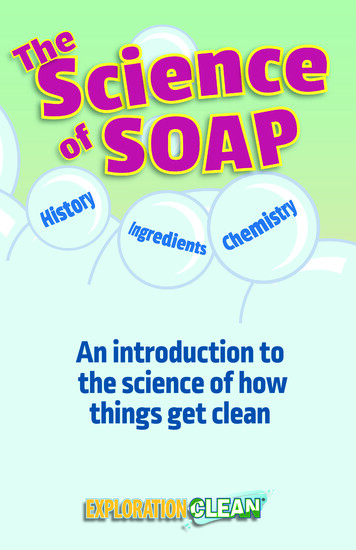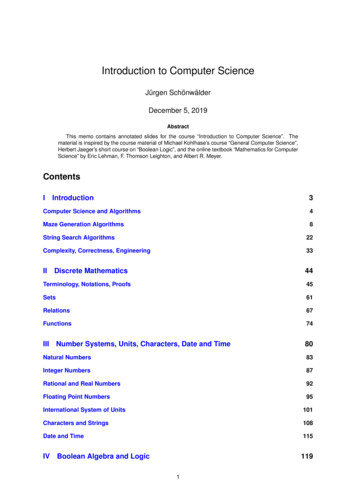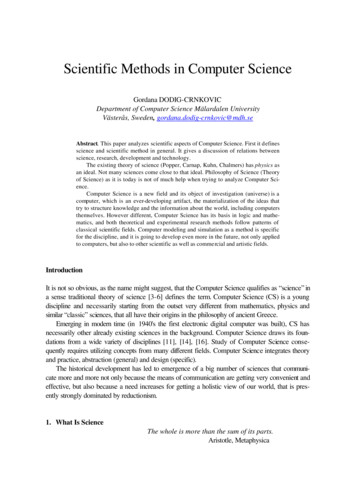
Transcription
An introduction tothe science of howthings get cleanEXPLORATION CLEAN
The American Cleaning Institute (ACI) recognizes that yourunderstanding of the science behind cleaning products is critical tothe trust you place in the cleaning products you might use every day.The Science of Soap is an introduction to how things get clean.Readers will find an overview of the history of soap and modernadvances of detergents, details about the chemistry of cleaning andthe power of the surfactant, and summaries of the variety ofsupporting ingredients that can often be found in cleaning products.ACI also acknowledges a need to advance the state-of-the-scienceused by industry to continuously ensure soap and cleaning productsare safe, effective, and sustainable. The Science of Soap is intendedto give tomorrow’s innovators a glimpse of the creative chemistriesat work in soaps and detergents, inspiring them to consider pursuingcareers that further advance the science of soapACI hopes that users of cleaning products, inquisitive students,aspiring scientists, and enthusiastic educators find The Science ofSoap a valuable resource of information about cleaning products.We encourage you to check out explorationclean.org for even moreresources and activities. 2019 American Cleaning InstituteAll rights reserved.ContentsWhat Does Clean Mean?2The History of Cleaning4How Cleaning Works8The Chemistry of Cleaning10Understanding Product Ingredients14The Future of Cleaning27Meet the Characters of the Cleaning Court 28About Us30STEM Toolbox31
What Does Clean Mean?IntroductionCleaning products play an essential role in daily life. They can removedirt and stains from our clothes, dried on food from our dishes, andeven germs from our hands! Let’s learn more about the chemistrythat makes this happen.amounts of food, and many other soils that we do not want hangingaround.We clean almost everything we touch—from our bodies to ourbathrooms and everything in between.Cleaning is the process of taking something dirty—like your kitchencounter—and removing dirt, grease, and grime found on it. When weclean, we leave things better than they were when we found them.Cleaning helps remove dirt, microbes (like bacteria and viruses), smallAnd it is not just at home! Cleaning is needed at schools, in restaurants,at hotels, on buses, and especially in hospitals. The more people oranimals that go into a place, the more often it will need to be cleaned.Types of Cleaning ProductsWhere Are Soaps and Detergents Used?SurfacecleanersHand sanitizerHomeSchoolHand soapHBody ublictransportationRestaurantsHotels3
The History of CleaningSo where did cleaning come from?Evidence has been found that ancient Babylonians understood soapmaking as early as 2800 BC Archeologists have found soap-likematerial in historic clay cylinders from this time. These cylinders wereinscribed with what we understand as saying, “fats boiled with ashes”(a method of making soap).Records show ancient Egyptians bathed regularly. The Ebers papyrus, amedical document from about 1500 BC describes combining animal andvegetable oils with alkaline saltsto form a soap-like materialused for treating skin diseases,as well as for washing.Many other ancient civilizations also used early forms ofsoap. Soap got its name froman ancient Roman legendabout Mount Sapo. Rain wouldwash down the mountain mixing with animal fat and ashes, resultingin a clay mixture found to make cleaning easier.By the 7th century, soap-making was an established art in Italy, Spainand France. These countries were early centers of soap manufacturingdue to their ready supply of source ingredients, such as oil from olivetrees.But after the fall of Rome in 467 AD, bathing habits declined in muchof Europe leading to unsanitary conditions in the Middle Ages. Theuncleanliness of that time contributed heavily to illness, including theBlack Death, which occurred in the 14th century.4There is evidencefrom Babylonian claycylinder seals that soapwas being made therealmost 5,000 years ago.Still there were areas of the medieval world where personal cleanlinessremained important. Daily bathing was a common custom in Japanduring the Middle Ages in Europe. And in Iceland, pools warmed withwater from hot springs were popular gathering places on Saturdayevenings.The English began making soap during the 12th century. Commercialsoap making began in the American colonies in 1600, but was for manyyears a household chore rather than a profession.It was not until the 17th century that cleanliness and bathing startedto come back into fashion in much of Europe, particularly in thewealthier areas.Well into the 19th century, soap was heavily taxed as a luxury item inseveral countries. When the tax was removed, soap became availableto most people, and cleanliness standards across societies improved.As people became moreinterested in beingclean, they explorednew ways of makingsoap and experimentedwith new ingredients.5
A major step toward largescale soap making occurred in1791 when a French chemist,Nicholas Leblanc, patented aprocess for making soda ashfrom common salt. Soda ash isobtained from ashes and canbe combined with fat to formsoap. This discovery madeNicolas Leblancsoap-making one of America’sfastest-growing industries by 1850, along with other advancementsand development of power to operate factories.The chemistry of soap manufacturing stayed essentially the sameuntil 1916. During World War I and again in World War II, there wasa shortage of animal and vegetable fats and oils that were usedin making soap. Chemists had to use other raw materials instead,which were “synthesized” into chemicals with similar properties.These are what are known today as “detergents.”Today, most things we call “soap” are actually detergents. It hasbecome so common to call detergents “soap,” that most people wouldbe confused if you asked for a “liquid hand detergent” when shopping.Today the science ofsoap-making is bigbusiness. Over 60thousand are employedin the business, includingresearchers exploringnew ways to usechemistry to help makethe world a cleaner andsafer place.6Timeline of Cleaning2800 BCEarliest known evidence of possible soap-making in Babylon.1500 BCEgyptians made soap-like material from oils and salts.300 BCRomans bathed regularly and used soap to keep clean.400The fall of Rome brought about a decline in clean habits.600Soap-making became an established craft in Europe.1100Italy, Spain, and France became centers of soap-making.1600Soap-makers arrived at the Jamestown colony in North America.1700Nicolas Leblanc invented a way to make soda ash from salt in 1791.1800 Michel Chevreul discovered secrets of fat and soap chemistry. Ernest Solvay’s discoveries reduced the cost of making soap. Soap-making became America’s fastest growing industry by 1850.1900German scientists invented non-soap products called detergents.1926The American Cleaning Institute is founded.1950 American scientist invented laundry detergent. By 1953, the sale of detergents in the U.S. passed those of soaps.1960Introduction of stain removers and laundry powders with enzymes.1970Introduction of liquid hand soaps and fabric softeners.1980Introduction of cold water washing, dishwasher liquids,and concentrated laundry powders.1990Introduction of concentrated powders and liquids, fabricsofteners, dishwashing gels, and cleaning product refills.2012Product advances continue to provide new convenient cleaningoptions, like the liquid laundry packet.NextWhat will the future bring for cleaning? That depends on thenext generation of scientists, like you!7
ChemicalHow Cleaning WorksMechanicalThermalNext, let’s see what happens when we add mechanical energy.No matter the type of product you are using (soap or detergent), goodcleaning takes a lot of energy. Three different kinds to be exact: Chemical energy, provided by the soap or detergentMechanical energy, provided by a machine or by handThermal energy, provided by heating waterInside a washing machine, clothes move back and forth rubbingtogether with other items. This is mechanical energy. The rubbingactions helps to loosen the stain and free it from the surface of ourshirt. When you look in your washing machine and see laundrymoving, you are watching mechanical energy in action.Cleaning EnergyMechanical energycan even Thermalbe created by hand.MechanicalChemicalCleaning EnergyLet’s look at how all these elements work together.The final type of energy is thermal energy.Assume we have a great, big, oily, greasy stain on one of our favoriteshirts. Water alone is not enough to remove the stain and get ourshirt clean.Thermal energy means temperature. Warm or hot water can helpthe stain dissolve quicker. While warm water can help speed thingsalong, most laundry detergents today can work just as well at coldertemperatures.ChemicalNow let’s add some laundry detergent.The laundry detergent provides chemical energy. This energy iscreated because of the way the ingredients in the detergent interactwith the stain on our shirt. You cannot see it with your eyes, but themolecules in the detergent are attracted to the stain and help pull thedirt from the shirt to the wash water.Cleaning EnergyChemicalTo get somethingreally clean takes a lotof energy. Whetherthis energy is usedin a tub or a washingmachine, chemicaland mechanical energyare needed to get thebest results. Withdetergents that workin cold water, thermalenergy is lAll three types of energy need the right amount of time to work best.The more one type of energy is used, the less others are needed.For example, delicate clothes would be damaged bythe EnergymechanicalCleaningenergy of the washing machine and hotterinstead, we canThermaluseChemical water. SoMechanicalCleaning Energychemical energy—detergents—andincrease time to get them clean.MechanicalChemicalThermalThermalCleaning EnergyCleaning EnergyChemicalMechanicalThermalThis is the energy in the chemicalreactions in soap and ing EnergyThermalShaking and rubbing help free dirt andstains from t can speed up the reactions thathelp get things clean.9
The Chemistry of CleaningHave you ever seen a bead ofwater sitting on a surface? Thisis because water has a propertycalled surface tension. Thistension causes water to form abead on the surface of things likeglass or fabric. You can seesurface tension at work byplacing a drop of water onto acounter top. The drop will holdits shape and will not spread.Water-loving endAction: Drop of water flattensAction: Drop of water flattensSurfactants (yellow) cause water to losesurface tension, which is what keepswater separate from other materials.In order to clean the dirt on our clothes, the water needs to be ableto reach the surface. Water is able to get to the surface if surfacetension is reduced. To do this, we use a group of chemicals calledsurface active agents, or surfactants.Surfactants change how water behaves. When a surfactant is added,the surface tension is reduced. Now water can spread out and wet thesurface (e.g., clothes, dishes, counter tops) we are trying to clean.Now let’s look at what happens on the surface.Every surfactant has two ends. One end wants to be in water and theother does not.The water-fearing end is known as the hydrophobic end. Hydrophobiccomes from two Greek roots, hydro- (meaning water) and -phobia(meaning fearing). Have you heard the phrase “oil and water don’tmix?” This is important here!The water-fearing end of the surfactant is made up of hydrocarbonchains. A hydrocarbon is a molecule that is made of hydrogen andWater-fearing endLike a magnet has two ends, one end of the surfactant is attracted towater molecules while the other is repelled.carbon. The chains love oil and grease and will try to stay awayfrom water.The water-loving end is known as the hydrophilic end. We learnedWater-loving endhydro- is a Greek root meaning ‘water’. So, if -phobic means ‘fearing’,then -philic means loving. The water-loving end of the chemical isattracted to water.How these two ends interact with soil and water is theOil secretor grease intodirthow asurfactant works.Once the surfactant is addedto water, the water-fearing endstry to stay away from the water.They do this by organizing intothe shape of a sphere withthe water-loving ends on theoutside and the water-fearingends protected on the inside.This spherical shape ofsurfactants is called a micelle.10A micelle is a sphere made ofsurfactants. To show how surfactantsbehave, it is shown here as a circle.11Oil or grease in dirt
How surfactants cleanThis step-by-step diagram shows ahighly magnified view of how micellesof surfactants clear oil or grease indirt off a piece of cloth.Oil or grease in dirtFirst, the water-fearing ends ofthe surfactants drift toward somedirt particles.A micelle forms around a particle.This separates the dirt from thesurface it was on.With the dirt inside the micelle, thewater-loving ends of the surfactants,which are all on the outside of themicelle, are attracted to water andcan be washed away, with the dirtstill inside.The micelle is important because it is what traps the soil. Remember,the inside of the micelle is hydrophobic and does not want to be nearwater. The soil is also hydrophobic, so it likes the environment themicelle creates.The attraction of the soil to the inside of the surfactant micelle helpsloosen the soil from its surface. Once the soil lifts off the surface, itbecomes suspended in the water in the micelle. This suspension is alsoknown as emulsification of one liquid into another. Happy inside themicelle, the soil will not settle back onto the surface.Now that the soil is trapped in the micelle and the micelle issuspended in water, it is easy to wash the soil way.Remember the outside of our micelle loves water. So, as we rinse, themicelle floats away and we are left with a clean surface!12Soap mixing with oil under a microscope, forming micelles.13
Understanding Product IngredientsWhile surfactants are the major components of cleaning products,other ingredients are added to provide a variety of functions. Eachproduct formula is a careful balance of various ingredients that willwork best for what you are trying to clean.Let’s review these other commonly used ingredients:SurfactantsSurfactants provide most ofthe cleaning power in yourcleaning products today, butother ingredients are alsoneeded to make the bestproducts possible. Theseingredients help the surfactantwork better on different typesSurfactants are the most importantof soil. As we learned before,element of the soap, but are notsurfactants are the main forceused in the greatest amount.in cleaning and therefore makeup a big portion of cleaning formulations.It is also important to know that some surfactants are very good atremoving some types of soils, but not very good at removing others.Many cleaning products include two or more surfactants in theformula. The choice of surfactants determines where the product willwork best, such as for laundry, dishes, or counter-tops.BuildersBuilders are another important group of ingredients that help makecleaning products better. Builders give the surfactants a helping hand.They are found in a number of different kinds of products, but youneed less of them than you do surfactants.14Builders help make thesurfactant more powerful byreacting with minerals found inyour home’s tap water (such ascalcium and magnesium).The more minerals in yourwater, the “harder” the wateris. It is not bad to haveminerals in water, but it canCleaning products typically use aleave white marks on surfacessmall amount of builders, which(like dishes). When calciumprovide extra cleaning power.and magnesium are present inwater, they will stop surfactants from doing their job of removing soil.Builders help prevent this by keeping the minerals out of the way ofthe surfactants. This leaves the surfactants alone to focus on the soil.MagnesiumBuilderSurfactantCalciumMagnesium and calcium, two minerals that arecommonly found in tap water, can prevent surfactantsfrom doing their job well.MagnesiumBuilderSurfactantCalciumBuilders attract magnesium and calcium, leavingsurfactants free to do their work.15
SolventsLiquid cleaning products aresolutions (chemicals dissolvedin a liquid). Solvents arechemicals that help ingredientsstay mixed and give cleaningproducts the right thicknessso they are easy to use. Inaddition, organic solvents canhelp prevent liquid productsfrom freezing in cold climates.Without solvents, a productwill be very thick. In somecases this might be a goodthing (think of a bar of soap).But for other products, wewant the liquid to pour outof the bottle. When we addsolvents, we decrease theviscosity, meaning the liquidwill move faster when pouredout of the bottle. The solventalso helps to makes sure we donot end up with a separatedsolution—like when you havepulp at the bottom of yourglass of orange juice.SolventsLessMoreThe solvent is needed to dissolve allLess andSolventthe other ingredientsmakes up Morethe largest percentage MoreSolventMoreSolventIf little or no solvent is used, thecleaning solution will be thick.LessSolventLess16MoreSolventEnzymesEnzymes are powerful stainremoving ingredients. Theirpower is to break downstains—just like the enzymesin our digestive system helpbreak down the food we eat.Enzymes are not livingEnzymes make up only a small amountorganisms but are createdof cleaning solutions but have a bigimpact in breaking down stains.by microorganisms, likebacteria and fungi. In thelaboratory, we use carefully selected microorganisms and allow themto grow in a very controlled environment. As they grow, they producethe desired enzymes.In cleaning products, enzymes help to remove stains and help us towash clothes in cold water.MoreLessAspergillus oryzae, or Koji, is a filamentous fungus usedin the industrial production of enzymes.MoreThe more solvent is used,the thinnerSolventthe cleaning solution will be.Each enzyme is made up of amino acids placed like beads on a string.There can be anywhere between a hundred and a million amino acidsfor a single enzyme! The order of these amino acids determines theshape and function of the enzyme.17
When added to a detergentformula, each enzyme will beattracted to a certain type ofstain (like gravy or grass).Once the enzyme finds a stainit likes, it gets to work breakingit down into smaller pieces andremoving it from the surfacewe are trying to clean.It is now easier for thosesmaller pieces to be picked upby the surfactant micelle.Close-up of cloth with oil and grease stain(not to scale)Close-up of cloth with oil and grease stain(not to scale)How enzymes cleanOil or grease in dirtOil or grease in dirtFirst, ezymes (green) are attracted tocertain types of stains.And as we learned earlier,the micelle traps the stainparticles—causing them to bewashed away in the rinsewater, leaving a clean surface.Next, enzymes break down the staininto smaller pieces.Fragrance ArtFragrancesFragrances are a group ofingredients that providethe cleaning product with apleasant smell. They are notfound in every product, andBottle fillsup with a small amout of fragrance.typically a veryAction:smallamountPercentage range appears. Levels to come.can make a large difference insmell. In many cases, thefragrance is the driving factorFragrances are optional, but if soapfor why someone decided tohas them, a little goes a long way.buy a specific product.A fragrance is a mix of manySurfactantartappear.different substances.TheseAction:Lemonand lavenderLittledropletsappear to forfloat outandbottlethe plants,suggestingingredients may unds (that come frommaterials like flowers, fruit,trees, plants, or nuts), essentialoils, or synthetic compounds.Lavender and lemon are twocommon fragrances that canbe found in cleaning products.Lavender blossoms and lemon juiceare two ingredients sometimes usedto make fragrant smelling soaps.One exampleof how aAction: A sock appearsfragrance might be createdis through a process called distillation, where the material is heateduntil it becomes a gas, and then the fragrant part is cooled down andcondensed back into a liquid to be collected.One type of fragrance technology is called encapsulation, which meansfragrances are enclosed in a type of shell until caused to burst.18Finally, surfactants are attracted to theloose pieces and they wash away.Fragrances create a pleasant smell when added to a cleaning product.They can also help cover up odors from any of the other ingredients inthe formula.19
When you wash clothes with afragranced product, they notonly get clean, but the pleasantsmell is transferred onto yourclothes!Fragrance makes many peopleenjoy using the product. Thisfragrance may smell differentin the bottle, in the wash, andon freshly washed clothing.The smell in wash is called the“bloom.”PreservativesHow fragrances workJust like it is important toprevent food from spoiling,cleaning products need tobe preserved as well.Adding a small amount of apreservative protects theproduct from microorganisms.Fragrance can be encapsulated andplaced in cleaning solutions.A preservative is a substanceadded to a cleaning productPreservatives are powerful and youin order to make it stabledon’t need much for soap to remaineffective while it sits on your counter.and safe for a longerperiod of time. Without apreservative, it is possible for bacteria or fungi to grow in the product.This can cause the ingredients in the product (like surfactants andenzymes) to break down and not work as well. Adding a preservativeallows a cleaning product to stay on the shelf longer, both in the storeand in your home.So not only are your clothesclean, but they smell great too!Fragrances can also bedesigned to stay on clothes,which allows clothes to smellcleaner and fresher for a longperiod of time.Preservatives in soapThese capsules can be released overtime, giving your clothes a pleasantsmell just out of the wash.Preservatives in soapWith preservativesWithWith20.and for a long time after.WWithout preservativesWithoutThis is an artist’s impression of a petri dish showing what would happento soap over time if it had no preservatives. Microorganisms could growin the soap, making it less desirable to use.21
More acidicpH ScalepH AdjusterspH adjusters are used in cleaningproducts to raise or lower thepH of a solution, making it eithermore basic or acidic.Every cleaning product needsto be “balanced” to work welland to be safe for your skin. Inorder to do this, chemists usepH adjusters to make sure theproduct is balanced and safefor you to use. The amountused depends on the otheringredients in the formula.How to adjust pHpH AdjusterChemists make sure that theproduct is effective whilebalancing safety, in part, bymaking sure the pH will not beharmful if it touches your skin.pH adjusters make up twiceWhat is pH? pH is how weas much of a cleaning solution aspreservatives, but that still is not a lot.measure if a solution is acidic(like lemon juice) or basic (likebaking soda). The pH scale is read from 0 to 14, and tells us if a solutionis acidic or basic. Pure water has a pH of 7, which means it’s neutral.If the pH is less than 7, then thesolution is acidic. Lemon juicehas a pH around 2. Our skin isslightly acidic, with a pH onaverage near 5. If our skin comesinto contact with a chemical thatis too acid it can cause itching ordiscomfort.4.0 - 5.5NeutralThe pH adjusters raise or lower thepH ScalepH of a solution,making it eithermore acidic or basic.pH AdjusterIf the pH is greater than 7,then the solution is basic. Forexample, baking soda has a pHof around 9. If a solution is tooalkaline (basic), it can also irritateyour skin.1422Lemon juice is acidic with a pH of about 2. Baking soda is on theother end of the pH scale, with a value of about 9.Adjusting the pH helps to keepthe product working well. It alsoaffects how the product cleans.For example, each surfactanthas a different pH range in whichthey are the most powerful.Therefore, a chemist may wantto adjust the pH to that level.Adjusting the pH level of a solutionpH Scalecan make it moreeffective at cleaning.One way of determining the pH of asolution is to use litmus paper, whichturns different colors depending onthe acidity of the solution.23
DyesThickenersDyes are sometime used togive a product a color. Thiscan make a product moreappealing to a shopper atthe store.Thickeners give soap theprop er viscosity (thickness),making sure it can flow out ofa bottle slowly enough to avoidspills. Can you imagine tryingto wash your hands with asoap that feels like water?It would run right off ofyour skin!Just a little bit of thickener can changethe consistency of a cleaning solution.Other ingredients may not add a lotof volume, but they add importantcharacteristics.More thickenerLess thickenerHow thick or thin a cleaning solution is can be controlledby using more or less thickener.Foam EnhancersFoam Enhancers help createsuds or bubbles. While notnecessary for effectivecleaning, many people feelbubbles show that a productis working.24Colorful dried flowers at a market in Morocco add color and fragrance to soaps.Only a little foam enhancer is needed,too much would quickly cause a mess.25
The Future of CleaningAntibacterial orDisinfecting IngredientsCleaning technology has come a long way from the ancientBabylonian way of soap-making. Today’s cleaning products are theresult of thoughtful design, experimentation, and safety testing.Cleaning washes away germswith any dirt and soil that isremoved, but a further reductionof germs can be achieved byusing additional ingredients thatwill actually kill germs.Antibacterial or disinfectingingredients can be included in acleaning or hand hygieneproduct, or used separatelyafter cleaning. Their useprovides a further reduction ingerms on our hands or surfacesin our homes. This reduction ofgerms helps to prevent peoplefrom getting sick whencommonly used surfaces, suchas door handles or our hands, arecleansed using these products.In environments with sickindividuals or where food isprepared, this is especiallyimportant.There are many differenttypes of antibacterial ordisinfecting ingredients.Depending on the choseningredient used in a product,it may be more effective oncertain microbes that make ussick like bacteria, viruses or mold.26The type of product and location ofuse will determine if an antibacterialagent is needed and how much to add.The machines we use to clean have also improved, becoming moresustainable and friendly for our environment. So far we have beenable to make new cleaning products that allow us to wash in coldHigh Energy (HE) Machineswater (saving energy from water heating), wash with less water,and make packaging smaller (to save material and avoidshippingUsecold waterextra weight).Use less waterUse lessenergyFuture scientists will have a great opportunity to continueto createnew cleaning design products that will continue to keep us healthyand do even more to help protect human health and the environment.Could that scientist be you?High Energy (HE) MachinesHigh Energy (HE) MachinesUse cold waterMicroscopic images of Tuberculosisand E Coli, pathogens that can bekilled by products with antibacterialor disinfecting ingredients.Use cold waterUse cold waterUse less waterUse less waterUse less energyUse less energyUse less waterSave electricityThrough a combination of innovation and federal energy efficiency standards,HighEnergy (HE) Machinesthe efficiency of home appliances has dramaticallyimproved.Today’s models use far lessenergyand waterthose of a decade ago.HighEnergy(HE)thanMachinesUse cold waterUsing less water and colder water means we can save electricityand helpsupportplanet.UsecoldourwaterUse less water Use less waterUse less energyUse less energy27
Learn about the science of cleaning, find out about creative careers and meetthese fun characters from the Kingdom of Clean at www.explorationclean.orgMeet the Charactersof the Cleaning CourtDid you ever imagine it took somany ingredients to help soapsand detergents do their job well?Well, meet the characters of theCleaning Court of the Kingdomof Clean. Each has a differentrole in making the kingdom andcourt run me characters, such as SirFactant and the Master Spy,N. Zyme, are critical to cleaning.Others, such as Sally Vent,help things run smoothlyand protect soaps fromdeteriorating.And some of the courtiers, suchas the Duke and Duchess ofScent and Count pH Adjuster,make soap more pleasant andeffective to use.pH AdjusterpH AdjusterLearn about the science of cleaning, findthese fun characters from the Kingdom opH AdjusterLearn aboutthe science of cleaning, find out about creative careers and meeethese fun characters Nfromof Clean at www.explorationclean.oymKingdom. ZtheSMasterSolventPreservativesEnzymesand AntimicrobialsLearn aboutthe science of cleaning, find out about creativecareers and eanatwww.explorationcleanEnzymesand asterPreservativesand FragranceSolvent28Fragrancepyeas.teZr ySmMpy NSolventIt may be easier (and morefun) for you to remember theingredients of cleaning productsand what they do by learningthe names of these importantcharacters and their roles.FragrancepH AdjusterZyme.NypSrMastepH AdjusterEnzymes29
About UsSTEM ToolboxThe American Cleaning Institute (ACI) is an organization ofcompanies in the U.S. Cleaning Products Industry, includingproducers of household, industrial, and institutional cleaningproducts, their ingred
We clean almost everything we touch—from our bodies to our bathrooms and everything in between. And it is not just at home! Cleaning is needed at schools, in restaurants, at hotels, on buses, and especially in hospitals. The more people or animals that go into a place, the more often it wil











